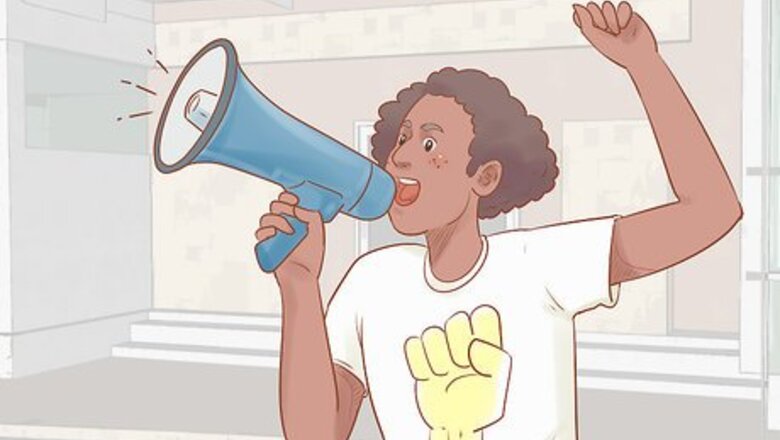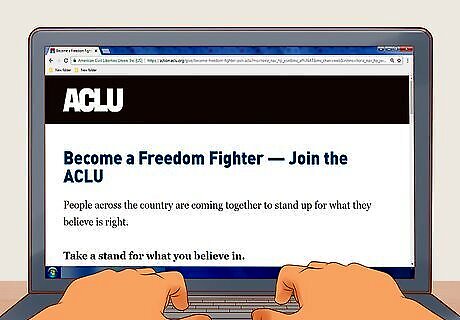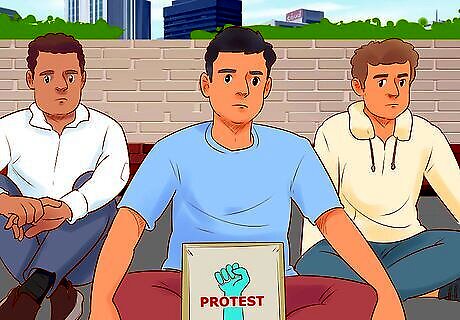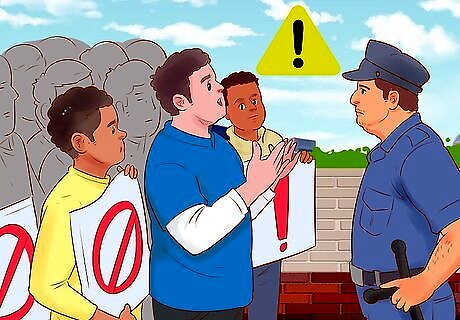
views
Familiarizing Yourself with Protesting

Know your right to freely protest in school. So long as your protesting activities don't disrupt school functions (i.e. prevent other students from attending class, or other faculty members from doing their jobs), you're in the clear to speak, hand out flyers, or wear a piece of clothing in support of a cause or organization you're for. What sorts of activities are considered disruptive is up to the school, but censoring speech on the grounds that they dislike it doesn't count. In the United States, students have their First Amendment right to free speech to speak out against policies or changes they oppose. You are legally allowed to speak on any topic you want, so let anyone who tries to stop you know this.

Choose a topic of local concern you strongly feel needs to change. To drum up support in the community, decide on something that's specific to your school or district that you feel is a big enough issue to protest over. Topics might regard the distribution of the school's budget, a dress code you disagree with, lack of resources available to students, or unfair treatment of the students by faculty. Addressing your school's concerns will allow you to drum up local support among the student body and the larger community familiar with the issues. If a community is rather artistically inclined, when it comes time to gather signatures for keeping art programs funded, you'll have an easier time getting help with a problem that affects everyone in town with kids.

Register your protest online with the American Civil Liberties Union (ACLU). If your protest is in regards to larger societal concerns, such as gun control laws or police brutality, look into work being done by national support networks or organizations such as the ACLU. They can help coordinate efforts for how your school as a whole can participate in nationwide demonstrations of solidarity. They have a listing of nationwide protests called People Power you can add yours to, allowing others to know about your protest and come join you.

Be aware of what punishments your school may use for protests. Threats of detention or suspension are some of the most common seen during student protests. Not every student who protests can be punished, but leaders may be targeted in order to discourage others from following them. Keep firm in these instances, and counter it by increasing your list of demands. Know that while you can be punished for missing class, you being given a worse punishment based on the nature of your protest is illegal. If you can, try not to even break rules with your protest. If you're threatened with trespassing, nothing can be done if you're protesting on public space, such as a sidewalk. Have one of the leaders maintain a low profile, avoiding speech making and drawing attention to themselves. This way, if the more outspoken leaders are punished or detained, they can step up to lead and state that they won't give in unless the original leaders are allowed to come back to the protest.
Gathering Support from the Community

Ally yourself with supporting faculty willing to help. It may be difficult to find anyone, as they may fear the backlash of the school's authority figures themselves. See if there isn't anyone around the school willing to speak with you privately, and ask them their thoughts on the issues you wish to protest. If their opinion on the topic lines up with yours, use the opportunity to discuss what can be done about the concerns you have, without someone like the principal finding out. Listen closely to any feedback faculty members may provide, as they can offer advice and assistance on how to persuade adults, and better frame and explain your arguments to the community.

Start a discussion at a school board meeting about your concerns. Most states have laws requiring agendas for public meetings to be posted before they happen. Gather up your classmates involved with the protest so they're present when issues important to you are considered. Make sure you've all done ample research on the subject beforehand. This way when you speak, you'll sound informed, persuasive, and have to ability to talk about how the benefits of current policy are either poor or non-existent. If during researching you find out your concerns have an economic impact on the district or school, bring up how addressing them can help save money, or will be worth the investment in the long term. Most meetings have time set aside for the public to speak. You may have to put your name on a sign in sheet.

Become involved as a member of the school board if you're old enough. If you or anyone in your group is the minimum age to run (sometimes only 18 years old), then consider having them gather the required amount of signatures, and filling out the forms to register to be on the ballot for the next school board election. School Board elections generally have small turnouts. The school board may reconsider its position on certain issues if it knows the graduating class has candidates in positions, and that their classmates would turn out to vote them in. Use this to your advantage. The classmate running should be aware of needing to commit to further duties beyond just the protest issues if they do win the vote.

Schedule a time to politely speak with a school authority figure. Sometimes all it takes is opening a dialogue between yourself and the other party, asking if changes can be made. You'll be surprised what can be achieved this way. Depending on who they are, they may also simply dismiss you immediately, but you will at least have asked politely before taking a more confrontational tone, not allowing your behavior to be blamed for talks going south. Don't allow yourself to be given the runaround by a principal's secretary, who may be ordered to not allow you to schedule an appointment, or will schedule appointments the principal intentionally blows off. If you're ignored, try reaching out to an even higher authority than the figure you're having problems with. If your principal is ignoring you, letting his superintendent know he isn't listening to student concerns may finally get his attention.

Gather petitions to present to the school authority. On a piece of paper, state your cause for gathering signatures, and when you approach students to sign, have them print their name clearly and include a form of contact. Make photocopies, and scan it into your computer to have a database of your supporters' information. When enough signatures have been gathered, include a letter when you're submitting it, stating how many students agree with the cause you're fighting for, and asking for an appointment to discuss the petition. Authorities may try to stop your signature gathering, thinking it can lead to something bigger. Avoid bringing already filled out sheets with you when gathering new signatures. If they try to bully you to stop or to take your pages, let them know it's illegal, and you can contact your congressperson or the ACLU about this. Keep a jar or cup with you to collect any potential donations of change, which you can say you'll be using to make photocopies and prints.
Holding a Protest

Wear clothing with any message, so long as it's within dress code. Schools often have “content-neutral policies” referring to rules not based around the messages something gives off, but rather about an item itself, to avoid issues based around censorship. For example, a school can ban hats as part of the dress code, but if hats are permitted, they can't ban someone from wearing a hat that's pro-NRA or has something on it supporting LGBT folk. Some schools do specifically ban clothing with inappropriate material on it, such as violence, pornography, drugs, curse words, or something racist. If your school requires a uniform, consider adding a patch to it saying something in support of your cause. This way you won't be going against the dress code.

Organize a walk-out rally outside the school. Since your school's funds are based on attendance, students missing class will get a huge reaction from the administration who will want to put a stop to it immediately. Have all the student supporters meet in an easily noticeable location near the school to bring as much attention to yourselves as possible from those in the school, and onlookers to your protest. Feel free to make signs in support of your cause to hold up, or make a chant of what your protest is about. Keep in mind that a walk-out can easily attract the attention of reporters and journalists. If you want to keep the media out, consider holding an “indoor walk-out” in the school lobby, auditorium, or gym.

Stage a sit-in to force school administration to listen. If you're continuing to have a hard time getting your voice heard, have student supporters crowd into the main office of the school where the principal or superintendent's offices are. You'll be causing students to miss class, but also disrupt work at the school from being done, which will be costing it money. Refuse to leave until your demands are met, but realize this may cause them to issue out punishments to make you leave. Try to reason with the principal that giving out punishments won't get students back to class, but meeting your demands will end the protesting. However, a principal just looking to get the students out of their office may simply punish everyone involved.

Contact your local state or federal congressperson to ask for support. Since public schools (and publicly-funded charter schools) are funded by the government, you are able to reach out to your local officials for their support in helping you resolve the problem. Contact their offices, and you'll be put in touch with their case worker who helps resolve problems their constituents have. A call from a government official to your school can be the deciding factor in having protestors' demands heard.

Be weary when dealing with police. Police may be called in as an intimidation tactic to end a protest, or when trying to have students removed from the premises during a sit-in. The officers most likely don't want to escalate the situation and arrest anyone, and chances are you can reach a compromise with them, such as agreeing to move sit-in students from the office to the hallway. If an agreement can't be made, police may threaten or make arrests. Again, not every student protesting can be arrested, but protest leaders may be targeted to discourage others from continuing. Ask the student supporters if any of them are willing to be arrested for the protest. If many say yes, then you'll know you can pursue more aggressive protesting tactics if need be.

Understand the risks and rewards of media involvement. Getting the public's attention will put increased pressure on the school to change its ways. Unfortunately, it can also make a particularly staunch principal buckle-down on their stances, and refuse to give in for the sake of looking weak. Reporters may fear getting arrested for trespassing at the school, so make sure if you invite them, it's to report on a rally set off school property. The media can also help to serve as moral support for the students, showcasing how important their protesting is in helping to bring policy change that benefits students' experiences in school.

Keep student protestors' morale high. Especially in the case of longer protests, you'll want to help prevent students losing steam and wanting to give up. To keep energy sustained, try coming up with multiple chants to change between, have the protestors march around the campus, and hand out drums, noise makers, and other musical instruments to have accompany your rallying. Make a sign to have passing cars honk their horns if they support the cause of your protest, which your principal will realize is the case each time he hears a car horn. Use social media to help keep discussion of the issues going outside of school, and to schedule and invite students to new protests.


















Comments
0 comment